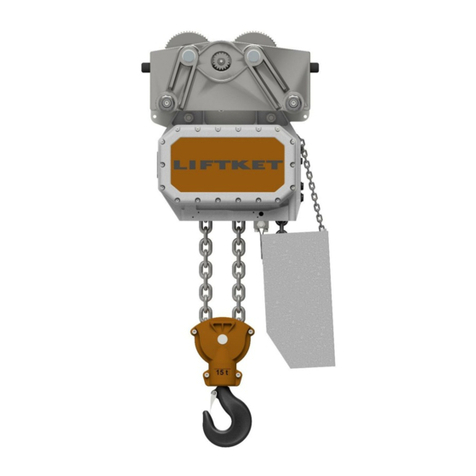3
Contents
1Safety instructions .......................................................................................................................................5
1.1 Regulations..................................................................................................................................................5
1.2 Advice for the use of electric chain hoists....................................................................................................6
1.2.1 Design according to DGUV V54 (BGV D8)..................................................................................................6
1.2.2 Additional requirements when designed according to DGUV V17 (BGV C1) ..............................................7
1.3 Prohibitions of use.......................................................................................................................................7
1.4 Directions for use.........................................................................................................................................7
1.5 Visible damages ..........................................................................................................................................8
1.6 Special features of electric chain hoists according to DGUV V17 (BGV C1)...............................................8
1.6.1 Prohibitions of use.......................................................................................................................................8
1.6.2 Moving of loads............................................................................................................................................8
1.6.3 Persons underneath suspended loads ........................................................................................................8
1.6.4 Types of loads .............................................................................................................................................8
1.6.5 Attaching lights or other equipment to the electric chain hoists ...................................................................9
1.7 Spare parts..................................................................................................................................................9
2Technical overview......................................................................................................................................9
2.1 Assembly.....................................................................................................................................................9
2.1.1 Standard version and version MB in upright use according to DGUV V54 (BGV D8)..................................9
2.1.2 Version MB in inverted use according to DGUV V54 (BGV D8)................................................................10
2.1.3 Version SB in upright use according to DGUV V17 (BGV C1)...................................................................11
2.1.4 Further completion possibilities .................................................................................................................11
2.2 Explanation of type designation.................................................................................................................11
2.3 Sectional view............................................................................................................................................12
2.4 Illustration of the load chain configuration..................................................................................................13
3Assembly...................................................................................................................................................13
3.1 Mechanical assembly ................................................................................................................................13
3.1.1 Hook tackle................................................................................................................................................13
3.1.2 Hook block.................................................................................................................................................14
3.1.3 Stationary electric chain hoist....................................................................................................................15
3.1.3.1 Hoist suspension with suspension eye ......................................................................................................15
3.1.3.2 Hoist suspension with single hole suspension eye....................................................................................16
3.1.3.3 Hoist suspension with hook suspension....................................................................................................17
3.1.4 Gear ventilation..........................................................................................................................................18
3.1.5 Chain box ..................................................................................................................................................18
3.1.5.1 Mounting the chain box..............................................................................................................................18
3.1.5.2 Oversize chain box....................................................................................................................................19
3.1.6 Assembling the load chain in single fall version.........................................................................................20
3.1.7 Assembling the load chain in double fall version .......................................................................................21
3.1.8 Replacing the load chain, the chain guide and the hold down...................................................................22
3.1.9 Lift limiter...................................................................................................................................................22
3.2 Electric connections...................................................................................................................................22
3.2.1 Mains power ..............................................................................................................................................22
3.2.2 Operating voltages.....................................................................................................................................23
3.2.3 Direct control .............................................................................................................................................24
3.2.4 Low voltage control....................................................................................................................................24
3.2.5 Electrical limit switches for lift limiting........................................................................................................25
3.3 Configuration of electric chain hoists according to DGUV V17 (BGV C1)..................................................25
3.4 Limit switches in upright use......................................................................................................................26
3.5 Limit switches in inverted use....................................................................................................................26
3.6 Operation and emergency limit switches ...................................................................................................26
3.6.1 Gear limit switches.....................................................................................................................................26
3.6.2 External emergency limit switches.............................................................................................................27
3.7 Incremental encoder..................................................................................................................................28
3.8 Mechanical underload protection...............................................................................................................29
3.9 Electronic overload and underload protection............................................................................................30
3.10 Control pendant.........................................................................................................................................32
4Electric chain hoist with trolley...................................................................................................................33
4.1 Types of trolleys.........................................................................................................................................33
4.2 Permissible curve radius............................................................................................................................33
4.3 Horizontal movement of electric chain hoists.............................................................................................34
4.4 Attachment of lightening devices to electric chain hoists...........................................................................34





























